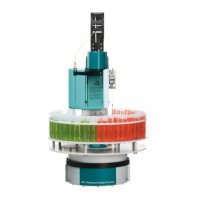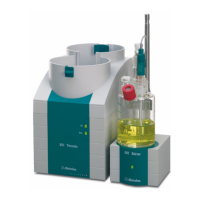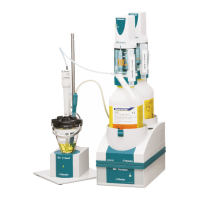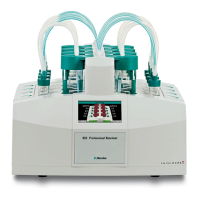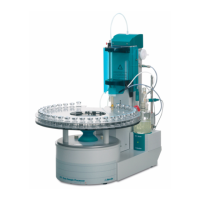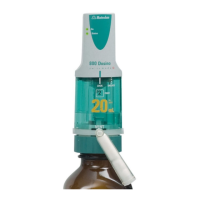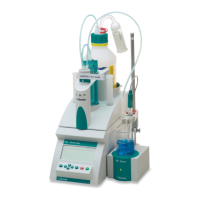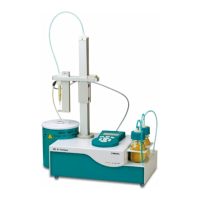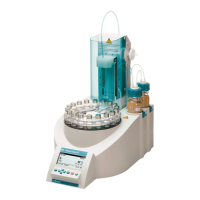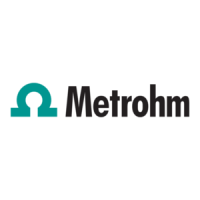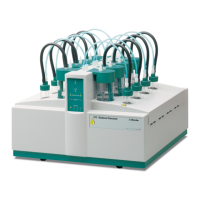Do you have a question about the Metrohm 855 and is the answer not in the manual?
Describes the role of the 855 Robotic Titrosampler within the modular Titrando system and its operation modes.
Details the different model versions, components, and intended use of the 855 Robotic Titrosampler.
Details the different model versions of the 855 Robotic Titrosampler and their specific components.
Lists and describes the main components of the 855 Robotic Titrosampler, including the turntable, tower, pumps, and connectors.
Specifies the intended application areas for the 855 Robotic Titrosampler in analytical laboratories and factories.
Explains the symbols, formatting, and conventions used throughout the manual for clarity and safety.
Explains the symbols, formatting, and conventions used throughout the manual for clarity and safety.
Provides comprehensive safety guidelines and warnings for operating the 855 Robotic Titrosampler.
Provides general safety guidelines and warnings for operating the 855 Robotic Titrosampler.
Outlines critical electrical safety measures, including warnings about opening the housing and qualified personnel.
Addresses safety considerations for tubing and capillary connections, emphasizing leak prevention and regular checks.
Details personal safety requirements, including protective gear and precautions when handling caustic liquids or glass vessels.
Lists safety precautions when working with flammable solvents and chemicals, such as ventilation and avoiding ignition sources.
Informs about the proper recycling and disposal procedures for the instrument according to European directives.
Illustrates and labels the front and rear views of the 855 Robotic Titrosampler, identifying key components.
Details the connectors and ports located on the back panel of the instrument, including USB and MSB connectors.
Explains the sensor connectors used for attaching electrodes and temperature sensors to the instrument.
Describes the function and types of sample racks compatible with the 855 Robotic Titrosampler, up to 48 cm diameter.
Covers the initial steps for setting up the instrument, including packaging, checks, and selecting a suitable location.
Instructions on handling and retaining the original packaging for safe transportation.
Guidance on checking the instrument shipment for completeness and damage upon receipt.
Recommendations for placing the instrument in a suitable laboratory environment, avoiding hazards.
Steps to prepare the Sample Processor, focusing on connecting the instrument to the power grid.
Detailed instructions and safety warnings for connecting the 855 Robotic Titrosampler to the power supply.
Explains the process of connecting the 855 Robotic Titrosampler to a computer via USB for control and software installation.
Instructions on how to connect the 786 Swing Head, including cable routing and tower configuration.
Details how to configure robotic arms, including necessary data entry and examples of standard model versions.
Provides instructions for mounting robotic arms, considering swing direction and limitation screw placement.
Describes robotic arms equipped with beaker sensors for detecting sample vessels and their functioning.
Guides on mounting various tubings for rinsing electrodes and aspirating sample solutions.
Instructions on properly routing tubing and cables within the guide chain to prevent strain on drives.
Steps for equipping the titration head, including installing rinsing tubings, aspiration tips, stirrers, and electrodes.
Explains how to connect rod or magnetic stirrers to the designated socket on the tower.
Details how to connect external pumps for aspirating different types of media.
Covers connecting various peripheral devices using the Metrohm Serial Bus (MSB) connectors.
Step-by-step guide for connecting dosing devices like Dosino and Dosimat, including ferrite core requirements.
Instructions for connecting magnetic stirrers and titration stands via MSB sockets.
Explains how to connect a Remote Box for controlling instruments via remote lines.
Describes connecting USB devices, including the instrument's function as a USB hub.
Details connecting a USB barcode reader for inputting text and numerical data.
Instructions for mounting a stand plate for applications requiring an external measuring cell.
Guides on installing a drip pan to prevent damage from spilled chemicals or liquids.
Steps for correctly attaching a sample rack to the turntable, including centering and fixing.
Emphasizes the mandatory installation of the safety shield before operating the instrument.
Lists common problems related to the Sample Processor, their causes, and remedies.
Addresses issues with the robotic arm's movement, Swing Head configuration, and rack position accuracy.
Discusses problems related to the pump, such as leaks and pressure issues, and provides solutions.
Explains the function and usage of the beaker sensor for detecting sample vessels on single-row sample racks.
Describes the two available model versions of rinsing nozzles for efficient vessel rinsing and cleaning.
Details the 6.2148.010 Remote Box for controlling devices not directly connectable to the MSB interface.
Explains how to adjust the stirring rate and provides a formula for calculating rotational speed.
Provides configuration data and descriptions for various titration robotic arms.
Presents detailed configuration data and specifications for robotic arms used in titration applications.
Lists configuration data for robotic arms designed for sample preparation tasks like pipetting and dilution.
Details robotic arms designed for specialized tasks, such as sample preparation with Polytron or handling vessel covers.
Provides pin assignment details for Metrohm remote interfaces, applicable to Remote Box and D-Sub connectors.
Provides general guidelines for operating and maintaining the 855 Robotic Titrosampler, stressing the importance of cleanliness.
Specific recommendations for the care of the instrument, including checking tubing connections and rinsing.
Details the galvanically isolated measuring interface, including potentiometry and polarizer specifications.
Covers the potentiometry measuring input for pH, redox, or ISE electrodes and reference electrodes.
Describes the measuring input for polarizable electrodes, detailing polarization current and voltage measurements.
Explains the temperature measuring input for Pt1000 or NTC sensors and automatic temperature compensation.
Specifies the stroke path, maximum lift load, lift rate, and turntable speed of the instrument.
Provides technical details for the membrane pump(s), including flow rate and pressure head.
Lists the technical specifications for the 786 Swing Head, including maximum load, swing rate, and sensor connector.
Details the various interfaces and connectors on the instrument, such as USB, MSB, stirrer, and pump connectors.
Specifies the voltage, frequency, power consumption, and fuse rating for the instrument's power connection.
Outlines the nominal function range, storage, and transport temperature conditions for the instrument.
Defines the standard reference conditions for temperature and relative humidity for accurate measurements.
Provides the physical dimensions (width, height, depth) and weights for different model versions of the instrument.
Instructions on how to find and download the list of available accessories for the product from the Internet.
Describes the role of the 855 Robotic Titrosampler within the modular Titrando system and its operation modes.
Details the different model versions, components, and intended use of the 855 Robotic Titrosampler.
Details the different model versions of the 855 Robotic Titrosampler and their specific components.
Lists and describes the main components of the 855 Robotic Titrosampler, including the turntable, tower, pumps, and connectors.
Specifies the intended application areas for the 855 Robotic Titrosampler in analytical laboratories and factories.
Explains the symbols, formatting, and conventions used throughout the manual for clarity and safety.
Explains the symbols, formatting, and conventions used throughout the manual for clarity and safety.
Provides comprehensive safety guidelines and warnings for operating the 855 Robotic Titrosampler.
Provides general safety guidelines and warnings for operating the 855 Robotic Titrosampler.
Outlines critical electrical safety measures, including warnings about opening the housing and qualified personnel.
Addresses safety considerations for tubing and capillary connections, emphasizing leak prevention and regular checks.
Details personal safety requirements, including protective gear and precautions when handling caustic liquids or glass vessels.
Lists safety precautions when working with flammable solvents and chemicals, such as ventilation and avoiding ignition sources.
Informs about the proper recycling and disposal procedures for the instrument according to European directives.
Illustrates and labels the front and rear views of the 855 Robotic Titrosampler, identifying key components.
Details the connectors and ports located on the back panel of the instrument, including USB and MSB connectors.
Explains the sensor connectors used for attaching electrodes and temperature sensors to the instrument.
Describes the function and types of sample racks compatible with the 855 Robotic Titrosampler, up to 48 cm diameter.
Covers the initial steps for setting up the instrument, including packaging, checks, and selecting a suitable location.
Instructions on handling and retaining the original packaging for safe transportation.
Guidance on checking the instrument shipment for completeness and damage upon receipt.
Recommendations for placing the instrument in a suitable laboratory environment, avoiding hazards.
Steps to prepare the Sample Processor, focusing on connecting the instrument to the power grid.
Detailed instructions and safety warnings for connecting the 855 Robotic Titrosampler to the power supply.
Explains the process of connecting the 855 Robotic Titrosampler to a computer via USB for control and software installation.
Instructions on how to connect the 786 Swing Head, including cable routing and tower configuration.
Details how to configure robotic arms, including necessary data entry and examples of standard model versions.
Provides instructions for mounting robotic arms, considering swing direction and limitation screw placement.
Describes robotic arms equipped with beaker sensors for detecting sample vessels and their functioning.
Guides on mounting various tubings for rinsing electrodes and aspirating sample solutions.
Instructions on properly routing tubing and cables within the guide chain to prevent strain on drives.
Steps for equipping the titration head, including installing rinsing tubings, aspiration tips, stirrers, and electrodes.
Explains how to connect rod or magnetic stirrers to the designated socket on the tower.
Details how to connect external pumps for aspirating different types of media.
Covers connecting various peripheral devices using the Metrohm Serial Bus (MSB) connectors.
Step-by-step guide for connecting dosing devices like Dosino and Dosimat, including ferrite core requirements.
Instructions for connecting magnetic stirrers and titration stands via MSB sockets.
Explains how to connect a Remote Box for controlling instruments via remote lines.
Describes connecting USB devices, including the instrument's function as a USB hub.
Details connecting a USB barcode reader for inputting text and numerical data.
Instructions for mounting a stand plate for applications requiring an external measuring cell.
Guides on installing a drip pan to prevent damage from spilled chemicals or liquids.
Steps for correctly attaching a sample rack to the turntable, including centering and fixing.
Emphasizes the mandatory installation of the safety shield before operating the instrument.
Lists common problems related to the Sample Processor, their causes, and remedies.
Addresses issues with the robotic arm's movement, Swing Head configuration, and rack position accuracy.
Discusses problems related to the pump, such as leaks and pressure issues, and provides solutions.
Explains the function and usage of the beaker sensor for detecting sample vessels on single-row sample racks.
Describes the two available model versions of rinsing nozzles for efficient vessel rinsing and cleaning.
Details the 6.2148.010 Remote Box for controlling devices not directly connectable to the MSB interface.
Explains how to adjust the stirring rate and provides a formula for calculating rotational speed.
Provides configuration data and descriptions for various titration robotic arms.
Presents detailed configuration data and specifications for robotic arms used in titration applications.
Lists configuration data for robotic arms designed for sample preparation tasks like pipetting and dilution.
Details robotic arms designed for specialized tasks, such as sample preparation with Polytron or handling vessel covers.
Provides pin assignment details for Metrohm remote interfaces, applicable to Remote Box and D-Sub connectors.
Provides general guidelines for operating and maintaining the 855 Robotic Titrosampler, stressing the importance of cleanliness.
Specific recommendations for the care of the instrument, including checking tubing connections and rinsing.
Details the galvanically isolated measuring interface, including potentiometry and polarizer specifications.
Covers the potentiometry measuring input for pH, redox, or ISE electrodes and reference electrodes.
Describes the measuring input for polarizable electrodes, detailing polarization current and voltage measurements.
Explains the temperature measuring input for Pt1000 or NTC sensors and automatic temperature compensation.
Specifies the stroke path, maximum lift load, lift rate, and turntable speed of the instrument.
Provides technical details for the membrane pump(s), including flow rate and pressure head.
Lists the technical specifications for the 786 Swing Head, including maximum load, swing rate, and sensor connector.
Details the various interfaces and connectors on the instrument, such as USB, MSB, stirrer, and pump connectors.
Specifies the voltage, frequency, power consumption, and fuse rating for the instrument's power connection.
Outlines the nominal function range, storage, and transport temperature conditions for the instrument.
Defines the standard reference conditions for temperature and relative humidity for accurate measurements.
Provides the physical dimensions (width, height, depth) and weights for different model versions of the instrument.
Instructions on how to find and download the list of available accessories for the product from the Internet.
| Manufacturer | Metrohm |
|---|---|
| Interface | USB |
| Power Supply | 100-240 VAC, 50/60 Hz |
| Application | Automated titration |
| Type | Robotic Titration System |
